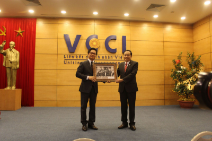Principle of reciprocity of the value chain in the CPTPP market
Vietnamese enterprises are exposed to many opportunities and benefits if they can take advantage of resources from imports and technology transfer when participating in the supply chain of FDI enterprises in CPTPP.
 |
|
Vietnamese enterprises expand exports and move deeper into the global value chain. Photo: T.Binh |
Exports grow remarkably
After 5 years of implementation, the Comprehensive and Progressive Agreement for Trans-Pacific Partnership (CPTPP) with its high level of market opening commitments has opened up many opportunities for Vietnamese enterprises to expand exports and move deeper into the global value chain. Besides, foreign direct investment attraction from CPTPP partners has also clearly improved.
At the seminar "Joining the supply chain of FDI enterprises - Increasing the efficiency of utilizing CPTPP", on December 2, Ms. Nguyen Thi Lan Phuong, Deputy Head of WTO and FTA Department - Multilateral Trade Policy Department (Ministry of Industry and Trade) said that the CPTPP Agreement h very positive benefits to Vietnam's import-export and investment activities.
Under the CPTPP, a lot of more preferential channels and advantages are available to exploit, especially in the context that some CPTPP member countries are traditional input sources for many manufacturing industries in Vietnam and holding global production supply chains such as Japan, Singapore, Australia, etc. From there, Vietnamese businesses can promote production and boost exports of goods to other member countries that are not under FTAs before CPTPP or to markets that are looking to become members of CPTPP in the future.
At the seminar "Joining the supply chain of FDI enterprises - Increasing the efficiency of utilizing CPTPP", on December 2, Ms. Nguyen Thi Lan Phuong, Deputy Head of WTO and FTA Department - Multilateral Trade Policy Department (Ministry of Industry and Trade) said that the CPTPP Agreement brings very positive benefits to Vietnam's import-export and investment activities.
In particular, there has been impressive growth in import-export turnover between Vietnam and CPTPP member countries, especially markets that have never had FTAs before. For example, with Canada, Mexico and Peru, there has been remarkable growth in import-export turnover. In 2023, Vietnam's import-export turnover with these non-FTA countries recorded about 12 billion USD, twice as much as in 2019 when there was no CPTPP; the trade surplus also grew significantly, from 5 billion USD to 9 billion USD in 2023.
The first 9 months of 2024 also witnessed growth results in import-export turnover between Vietnam and CPTPP countries, reaching more than 76 billion USD and growing by nearly 10% year on year.
In addition, foreign investors who are CPTPP members such as Singapore and Japan have actively approached the Vietnamese market to take advantage of the opportunities and advantages of this agreement.
As one of the enterprises with activities in connecting and linking with Japanese enterprises in particular as well as enterprises in the supply chain of multinational corporations, Mr. Nguyen Thanh Trung, Director of CNCTech Thang Long, CNCTech Group said that participating in the supply chain of FDI enterprises helps enterprises build strategic cooperative relationships with foreign enterprises; improve product quality. At the same time, this is chance to develop human resources, improve scientific and technical level, and be able to compete fairly with foreign companies.
Mr. Nguyen Trung Hieu, Head of Business Planning Department - Toyota Vietnam Automobile Company said that the company has had very close cooperation activities with Vietnamese suppliers in recent years. For Toyota, increasing domestic suppliers in Toyota's supply chain will increase the localization rate and search for domestic suppliers. Thanks to that, reducing dependence on foreign countries, manufacturers are much more proactive with domestic supply sources.
On the other hand, when applying the CPTPP Agreement, businesses have one more option, more opportunities to consider sources of components from Japan or from other members of the agreement. Moreover, the application roadmap of the CPTPP Agreement for the automobile industry is 0% around 2030 - 2031, which will enhance enterprise’s competition in the Vietnamese market.
Notably, “the perfect combination of input components for processing and manufacturing in Vietnam and exporting to a market in the CPTPP helps businesses find new customers as well as increase sales,” said Mr. Nguyen Trung Hieu.
Strengthening internal capacity to participate in the global supply chain
However, according to Ms. Nguyen Thi Lan Phuong, the implementation of CPTPP also shows that most of the enterprises taking advantage of these FTAs are FDI enterprises. Typically, enterprises in the fields of electronic components, footwear, textiles, computers, etc., while enterprises related to agriculture and fisheries, which are Vietnam's strengths, have relatively limited utilization.
In addition, the proportion of Vietnamese goods in CPTPP markets is still limited, not only CPTPP but also other new generation FTAs such as EVFTA or UKVFTA, which are only under 10%. With CPTPP markets such as Mexico and Canada, that rate is below 2% and the rate of utilizing incentives with CPTPP in 2022 was only about 5%.
The representative of the Multilateral Trade Policy Department said that there are many different solutions for businesses to take advantage of CPTPP or FTAs in general. One of them is to combine with FDI enterprises to form a supply chain. Because FDI enterprises are multinational corporations, have capital capacity, global management experience and leading advanced technology. If Vietnamese enterprises can enter the supply chain of FDI enterprises, they can learn from the "giants" to grow faster and integrate better internationally.
Therefore, in order to join the FDI chain or be ready to directly exchange with foreign enterprises and partners, Vietnamese enterprises themselves must make efforts to change to absorb the opportunities in FTAs.
On the contrary, it is not only Vietnamese enterprises that need to change, but also the cooperation of FDI enterprises. Because when FDI enterprises enter Vietnam, they also benefit from the value of Vietnamese land and from agreements such as CPTPP. Therefore, FDI enterprises also need to make efforts to accompany Vietnamese enterprises in training, sharing experiences and technology, and improving management capacity to be able to mature and meet the standards of becoming input suppliers for FDI enterprises.








